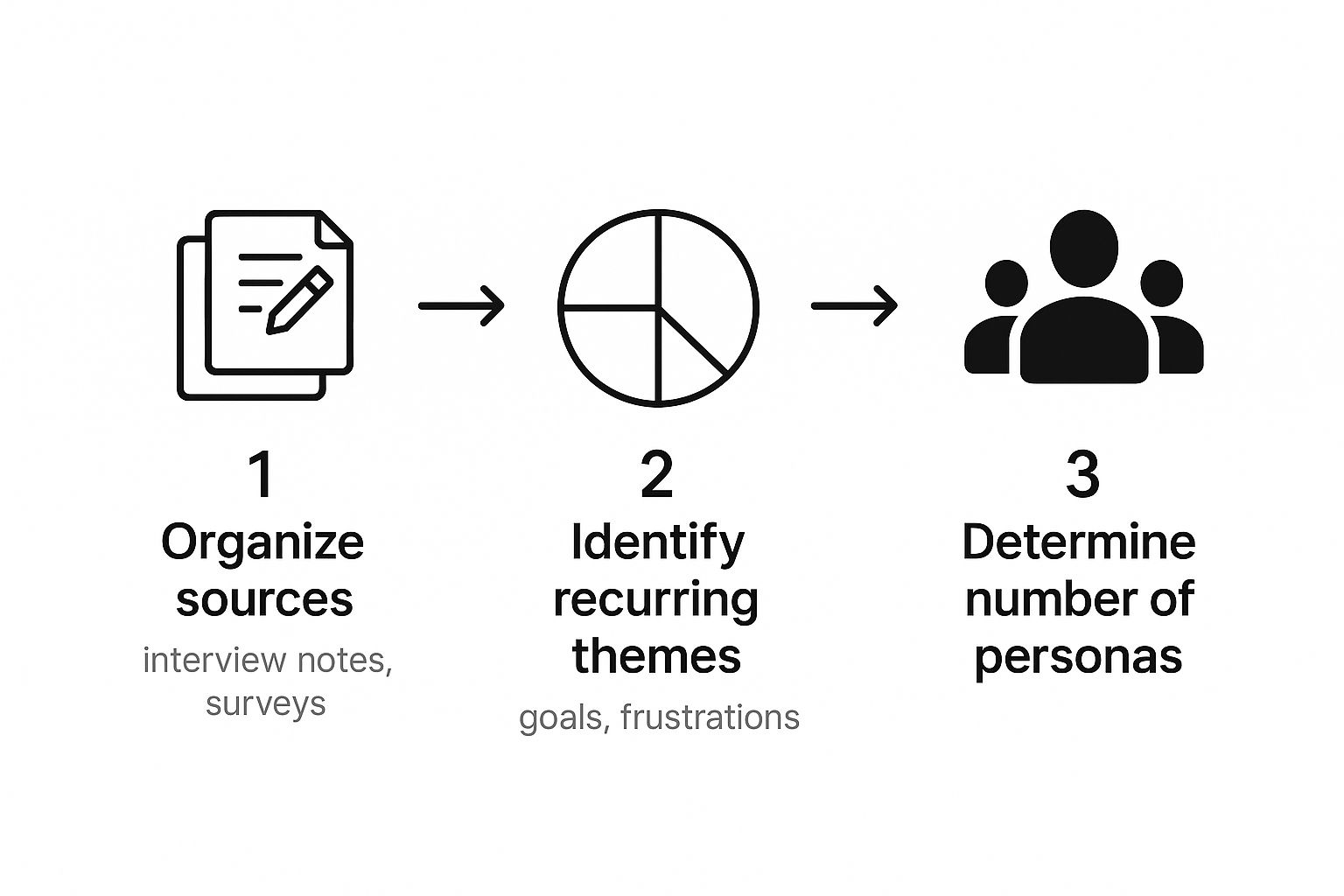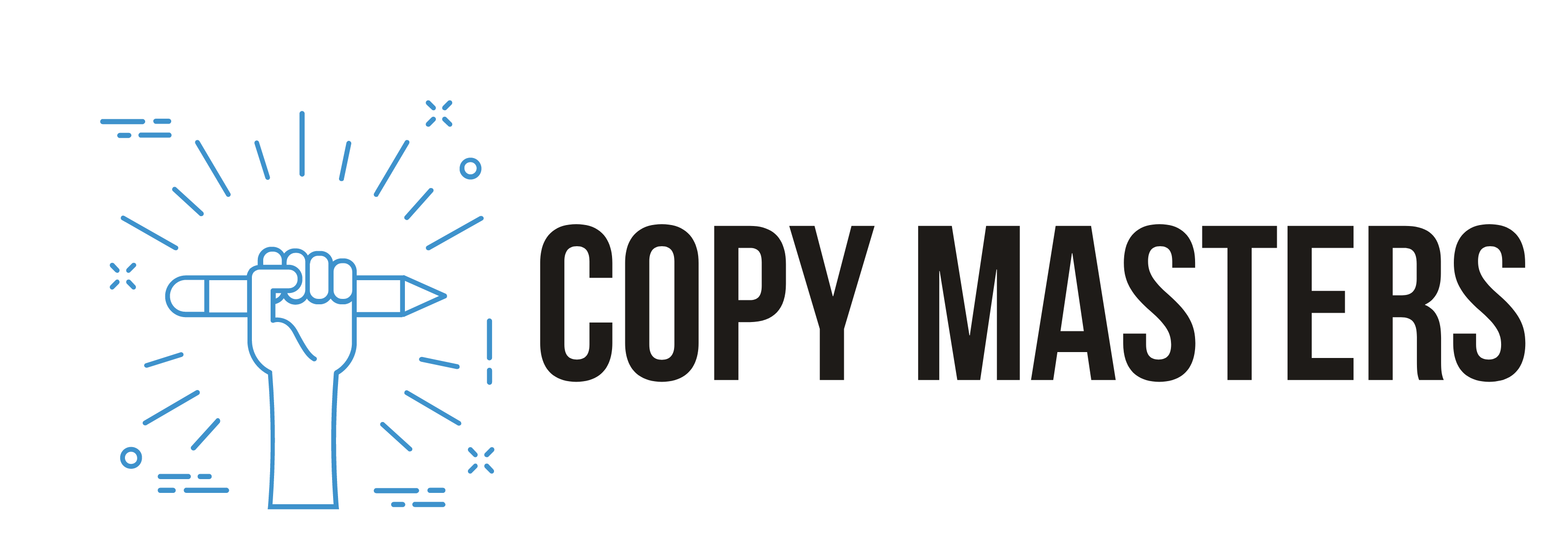Let’s be honest—most buyer personas are a complete waste of time. They’re cooked up in a conference room, given a cheesy alliterative name, and then promptly filed away in a Google Drive folder, never to be seen again.
Why does this happen? Because they're treated like a creative writing project instead of the sharp, strategic tool they’re meant to be. Truly effective personas aren't about stock photos and clever backstories; they're about digging deep to uncover the real-world motivations, headaches, and buying triggers of your absolute best customers.
Why Most Buyer Personas Are a Waste of Time

The biggest pitfall I see is teams building personas based on pure guesswork and internal assumptions. A marketing team gets together and invents "Marketing Mary," a persona they describe as "busy, tech-savvy, and focused on ROI." It's not wrong, but it’s so generic that it’s functionally useless.
This kind of surface-level profile leads to bland, forgettable messaging. The content you create for "Marketing Mary" might hit on ROI, but it completely misses the specific anxiety she feels before presenting campaign numbers to her VP. It doesn’t touch on her frustration with clunky software integrations or the constant pressure she’s under to prove her team’s budget is well-spent.
The Critical Shift from Fiction to Fact
Here’s the thing: the best personas aren’t invented—they're discovered. They need to be built on a solid foundation of real-world data and, just as importantly, qualitative insights you've gathered from talking to actual human customers. Making this switch from guesswork to an evidence-based approach is what turns a useless PDF into a compass that guides every single marketing decision.
When you learn how to create buyer personas the right way, you unlock some serious strategic advantages:
- You build genuine empathy. Suddenly, you’re not just looking at demographics. You’re understanding your customers’ daily frustrations and what they’re trying to achieve.
- Your messaging becomes incredibly targeted. Your copy, ads, and content start speaking directly to their specific pain points and goals, not just shouting into the void.
- Product development gets smarter. Insights from real customers can pinpoint exactly where you should innovate, showing you the new features that will actually solve their problems.
- Sales and marketing finally get aligned. Your sales team can walk into conversations knowing exactly what objections to expect and how to tailor their pitch to what the prospect actually cares about.
The difference between a useful persona and a useless one is simple: one is a mirror reflecting your actual customer, while the other is a portrait of who you think your customer is.
The data backs this up without question. We know that customer-centric companies are a staggering 60% more profitable than those that aren't. And a survey found that 82% of companies that used data-backed personas were able to create a much stronger value proposition.
There’s a clear, undeniable line connecting deeply researched personas to real business growth. If you're interested, you can dig into even more statistics about the impact of buyer personas on revenue and lead generation.
Gathering Data for Authentic Personas

Here’s the thing about powerful buyer personas: they aren’t dreamed up in a conference room. They’re discovered in data. The move from making assumptions to digging into real evidence is what turns a persona from a dusty PDF into a genuine strategic compass for your entire business.
This means you’ve got to roll up your sleeves and get comfortable with both quantitative and qualitative information. The best place to kick things off? The data you already have. It’s an absolute goldmine of behavioral truth, showing you what your customers actually do, not just what they say they do.
Tapping Into Your Internal Data
Before you even think about sending out a single survey, look inward. Your company's digital records are packed with unbiased information about your best customers. Knowing the essential market research types can give you a solid framework for how to approach this internal audit.
I always recommend starting with these three sources:
- Your CRM System: This is ground zero. Pull up the data on your most successful customers and look for common threads. What industries are they in? What’s their typical company size or job title? How long did it take to close the deal?
- Website Analytics: Tools like Google Analytics show you exactly what content people care about. Dig into the behavior of your best customers and see which blog posts, case studies, or service pages they visited before they converted. This tells you what they truly value.
- Support Tickets & Chat Logs: This is where you hear your customers’ real voices, unfiltered. Pay close attention to the exact words and phrases they use to describe their problems. These raw insights are priceless for crafting persona messaging that actually connects.
Conducting Meaningful Customer Interviews
The numbers tell you what is happening, but talking to people tells you why. There is simply no substitute for a real conversation. It's the most powerful way to build empathy and understand the human story behind all those data points. In fact, it’s a non-negotiable part of learning how to properly https://copymasters.co/blog/how-to-research-target-audience.
Your goal here isn't just to confirm what you think you know; it's to be surprised. I’ve found the best insights come from interviewing a mix of customers:
- Your Ideal Customers: These are the people who absolutely love what you do. Find out what makes them so successful with your product or service.
- Recent Customers: Their buying journey is still fresh. Ask them about the "aha!" moment that made them choose you over everyone else.
- Customers Who Churned: I know, these can be tough conversations. But they are often the most revealing. Find out where the disconnect happened and what roadblocks they hit.
A persona built on data isn’t just a profile; it's a strategic asset. It informs your product roadmap, sharpens your marketing message, and aligns your entire team around a shared understanding of the customer.
Just look at a real-world example: A fintech company used customer surveys to flesh out its personas and stumbled upon a major knowledge gap. It turned out many users didn't really understand the product tiers, which was tanking their adoption of paid features.
Armed with that insight, they clarified their messaging and redesigned their plans. The result? They projected a 29% increase in revenue and a 15% lift in new customer acquisition. That’s the kind of impact you get when you move from guessing to knowing. You can read more about how personas drive market success on simon-kucher.com.
Analyzing Your Research to Find Key Patterns
You’ve done the hard yards. You’ve sat through hours of interviews, picked apart survey results, and waded through a sea of analytics. Now, you’re staring at a mountain of raw data. This is the moment where the real magic happens—where you transform that jumble of notes and numbers into a living, breathing story about your customer.
The goal here isn't just to list facts. It's about playing detective. You need to connect the dots and uncover the deep-seated patterns that truly define your ideal buyers. It's the difference between noting "works in marketing" and understanding their recurring nightmare is "proving ROI to the C-suite with a shoestring budget." Those repeating themes are what will make your personas powerful.
Sifting and Sorting Your Data
First things first, you need to tame the chaos of your qualitative data—all those interview transcripts, open-ended survey answers, and customer support chats. A simple spreadsheet is your best friend at this stage.
Start by creating columns for the core insights you're hunting for:
- Goals: What are they really trying to accomplish in their day-to-day?
- Challenges: What specific roadblocks and frustrations pop up again and again?
- Motivations: What's the "why" driving them? Is it a promotion? Team recognition? Just making their own life easier?
- Direct Quotes: Pull out those golden, verbatim phrases that perfectly capture their mindset.
- Objections: What hesitations or deal-breakers did they mention?
Go through every single interview and survey response, methodically filling in your spreadsheet. This might feel tedious, but it’s a crucial step that forces you to see the forest for the trees, moving beyond one-off comments to spot the overarching narrative.
This infographic breaks down how you get from a pile of information to a set of distinct, useful personas.

As you can see, it's all about that critical jump from just organizing your sources to actually identifying the recurring themes that will give your personas real strategic value.
Distinguishing Segments from Personas
As you organize everything, clear patterns will start to surface. You might see a whole group of customers who are laser-focused on improving team efficiency, while another cohort is completely obsessed with their own personal productivity. These distinct clusters of goals and pain points are the foundations of your future personas.
Imagine a SaaS company looking at their research. They might spot two obvious groups:
- "Team Lead Taylor": This group's interviews are filled with mentions of collaboration bottlenecks and the headache of tracking project progress. Their success is measured by the team's output.
- "Solo Strategist Sam": This bunch talks more about managing their individual to-do list, automating menial tasks, and finding tools that play nicely with their current software stack. Their success is personal.
The key is to look for major differences in motivation and behavior, not just superficial demographics. If two people have the same core problems and goals, they probably belong to the same persona—even if one is a "Marketing Manager" and the other is a "Content Lead."
Deciding How Many Personas You Need
One of the most common pitfalls is creating a dozen different personas. It feels productive, but it ultimately dilutes your focus and makes it impossible for your team to act on them.
Here's my rule of thumb: create a new persona only if a segment needs a completely different marketing message or product solution to be won over.
Do "Team Lead Taylor" and "Solo Strategist Sam" require different sales pitches, blog posts, and feature announcements? If the answer is a resounding yes, then they absolutely should be separate personas. But if their core needs are 80% the same, it's far better to create one strong primary persona and simply note the minor variations.
For most businesses, 2-3 incredibly well-defined personas are infinitely more powerful than a dozen vague ones.
Putting It All on Paper: Building Your Persona Document

Alright, you've done the hard work. You’ve sifted through interview notes, survey results, and analytics, and you’ve spotted the patterns that define your ideal customer. Now comes the crucial step: translating that mountain of data into a living, breathing document your entire company can actually use.
This isn’t just a data dump. The goal is to build an actionable tool that feels less like a sterile case file and more like a story about a real person. This document will become the compass for everything your company does, from writing email subject lines to prioritizing product features.
Crafting a Compelling Narrative
The most powerful personas are the ones that build empathy. They give your team a genuine feel for your customer's world. To do that, you need to focus on three essential narrative elements that bring them to life.
Here's what I've found works best:
Primary Goals: Don’t stop at surface-level tasks. Dig deeper. What’s the real professional or personal objective they're striving for? A marketing manager’s goal isn’t just "launch a campaign"—it’s to "earn a seat at the leadership table by proving marketing's impact on revenue." That's a goal with motivation.
Key Challenges: Get specific about the frustrations that stand in their way. Use the exact language you heard in your interviews. Instead of a generic "needs better tools," drill down to the real pain: "struggles to consolidate data from five different platforms to create a single, coherent report for their VP."
A Day in the Life: This is where you make the persona relatable. Write a short, first-person narrative that walks through their typical workday. What’s their morning routine? Which meetings do they dread? What are the small wins they celebrate? This section is pure gold for helping your team understand their daily reality.
The secret to a persona that sticks? Use their words, not yours. Weave direct quotes from your interviews throughout the document. A problem described in their own language is infinitely more powerful than any summary you could write.
Think about it. A quote like, "I spend the first hour of every day just trying to figure out what’s on fire," tells you more about their daily stress than any bullet point ever could.
Adding Strategic Layers for Sales and Marketing
A truly great persona document doesn't just describe the customer; it tells your team how to connect with them. This is where you translate raw insight into actionable strategy for your marketing and sales folks. Two sections are absolutely critical here.
1. Messaging Hooks
This is where the magic happens. You directly connect their problems to your solutions. Based on their goals and challenges, what specific angles will grab their attention and make them think, "They get me"? These become your copywriting thought-starters.
- Example for a project management tool: "Stop chasing status updates. Get a real-time view of every project."
2. Common Objections
What roadblocks or hesitations came up during your research? Your sales team will thank you for this. List the potential pushback they’re likely to encounter and arm them with a smart, proactive response.
- Example Objection: "We already have a system that works well enough."
- Strategic Response: "Many of our customers felt the same way. They found that 'good enough' was costing them 10 hours a week in manual reporting and rework."
By building your profile with these narrative and strategic layers, you create more than just a document. You forge a shared understanding of your customer that empowers every single person on your team to make smarter, more empathetic decisions.
Anatomy of a Strategic Persona Document
Let's break down the essential components of a truly useful persona document. Think of this table as your blueprint for turning research into a tool your team will reference constantly. Each section answers a critical question and should be backed by real data.
| Section | Key Question It Answers | Primary Data Source |
|---|---|---|
| Basic Demographics | Who are they on paper? | Surveys, CRM Data, Market Research |
| Role & Responsibilities | What does their job actually entail? | Interviews, LinkedIn Research |
| A Day in the Life | What is their daily reality like? | Customer Interviews, Ethnographic Research |
| Goals & Motivations | What are they trying to achieve? | Interviews, Survey Open-Ended Questions |
| Challenges & Pains | What's standing in their way? | Interviews, Support Tickets, Customer Reviews |
| Watering Holes | Where do they go for information? | Interviews, Social Media Analytics, Forum Analysis |
| Messaging Hooks | How do we talk to them effectively? | Synthesis of Goals & Challenges |
| Common Objections | Why might they say "no"? | Sales Team Feedback, Lost-Deal Analysis, Interviews |
| Real Quotes | How do they talk about their problems? | Customer Interview Transcripts |
A document built with these components moves beyond a simple caricature. It becomes a strategic asset that aligns your entire organization around the most important person: your customer.
You’ve done the hard work and built out your buyer personas. That’s a huge step, but let's be honest—a persona document gathering digital dust in a forgotten folder isn't helping anyone. Its real power is unleashed when it’s actively used, day in and day out.
The whole point is to weave your personas into the fabric of your team's daily operations. They shouldn't be a "nice-to-have" reference; they should be a core part of the toolkit. For your content team, especially, this document is a goldmine waiting to be tapped.
Making Personas Actionable for Content and Sales
For anyone creating content, a well-defined persona is the ultimate cheat sheet. Look at the "Key Challenges" section of your persona template. Every single pain point listed there is a seed for an entire cluster of blog posts, social media updates, or video scripts. Once you've got your personas nailed down, they become indispensable for crafting a winning social media content strategy.
- Brainstorming Content: If a persona's main challenge is "struggling to prove marketing ROI," you've got instant topic ideas. Think "5 Underused Metrics That Actually Impress the C-Suite" or "How to Build a Marketing Dashboard Your Boss Will Love."
- Sharpening Ad Campaigns: Pull from the "Messaging Hooks" to write ad copy that hits home. An ad targeting that same persona could open with something direct like, "Stop Guessing. Start Proving Your Impact."
Your sales team can get in on this, too. The "Common Objections" section is priceless for them. It equips them to walk into calls already knowing the likely pushback. Instead of getting caught flat-footed, they can proactively address concerns with messaging that speaks directly to that persona's goals and fears.
Driving Product and Long-Term Strategy
This isn't just a marketing and sales game. Your personas should be a guiding light for your product roadmap. The "Primary Goals" section tells your dev team what your customers are really trying to achieve with your product.
If a key persona's goal is to improve team collaboration, a feature request for smarter notification controls should probably jump ahead of a new feature designed for solo users. It's about building what your ideal customer actually needs.
Personas aren't a "set it and forget it" exercise. They are living documents that need to be revisited and refreshed. Markets shift, customer needs evolve, and your personas must reflect that reality. Make it a habit to review them every six to twelve months to keep them sharp.
Putting in this effort to integrate your personas pays off, big time. Companies that use them see a 14% increase in client retention and a 19% boost in revenue growth. Even better, segmented email campaigns based on personas can generate 18 times more revenue than generic, one-size-fits-all blasts.
When you activate your personas across every department, they stop being a simple marketing exercise and become a core driver of your entire demand generation strategy.
Answering Your Top Buyer Persona Questions
Even with the best guide, a few questions always seem to pop up when it's time to actually build your personas. I've been there. Getting these details right is what makes a persona a powerful tool instead of just another document gathering dust.
Let's clear up some of the most common stumbling blocks.
How Many Personas Should We Actually Create?
The classic consultant's answer is "it depends," but here's a more practical take: aim for as few as you can get away with. For most companies, that sweet spot is somewhere between two and three core personas. Any more than that, and your focus starts to splinter.
My advice? Start with just one—your absolute best, most profitable customer type. Nail that one first, then expand if you need to.
You only really need a separate persona if a group of customers has fundamentally different problems, goals, or buying processes that require a completely different message. If their core motivations are the same, even if their job titles differ slightly, they can probably live under the same persona umbrella.
It's a classic rookie mistake to create a dozen personas. If you can't imagine building a unique content plan for each one, you have too many.
But What if We're a New Business and Have No Customers?
Great question. When you're just starting out, you can't interview your customers because you don't have any yet. So, you build "provisional personas" based on smart, educated guesses. Your research just shifts from your own CRM to the wider market.
Here’s how to do it:
- Talk to Potential Customers: Find people who fit the description of who you think your ideal customer is. Offer them a gift card for 30 minutes of their time and ask them about their daily challenges.
- Become a Competitor Spy: Dive deep into the reviews and testimonials of your direct competitors. What specific problems are people crediting them with solving? What language do they use to describe their pain points? This is pure gold.
- Lurk in Online Hangouts: Where does your audience spend time online? Find those subreddits, LinkedIn Groups, or industry forums. Pay attention to the questions they ask and the frustrations they vent about.
These first-draft personas won't be perfect, but they give you a direction. From there, it's all about testing those assumptions with your early content and marketing efforts. You can learn more about this in our guide on how to measure content performance.
Aren't Personas Just a Fancy Term for a Target Audience?
Nope, and this is a crucial distinction.
A target audience is a broad, demographic snapshot. Think of it as a wide-angle shot: "Marketing Managers, aged 30-45, working at US-based SaaS companies." It's useful, but it's impersonal.
A buyer persona is the close-up. It's about a single, fictional person who represents that broader group. We give her a name (like "Marketing Megan"), a backstory, specific frustrations she deals with every day at her job, and career goals she's trying to hit.
Your target audience tells you who to talk to. Your persona tells you how to talk to them like a real human being.
- SaaS SEO Consulting for Predictable Growth - October 20, 2025
- What Is SEO Management Your Guide to Real Results - October 19, 2025
- A Guide to Quality Content for SEO That Ranks - October 18, 2025
